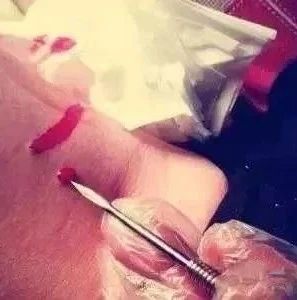Click the top left ↑ “Daoist Medicine Chen Ming” to follow the public account

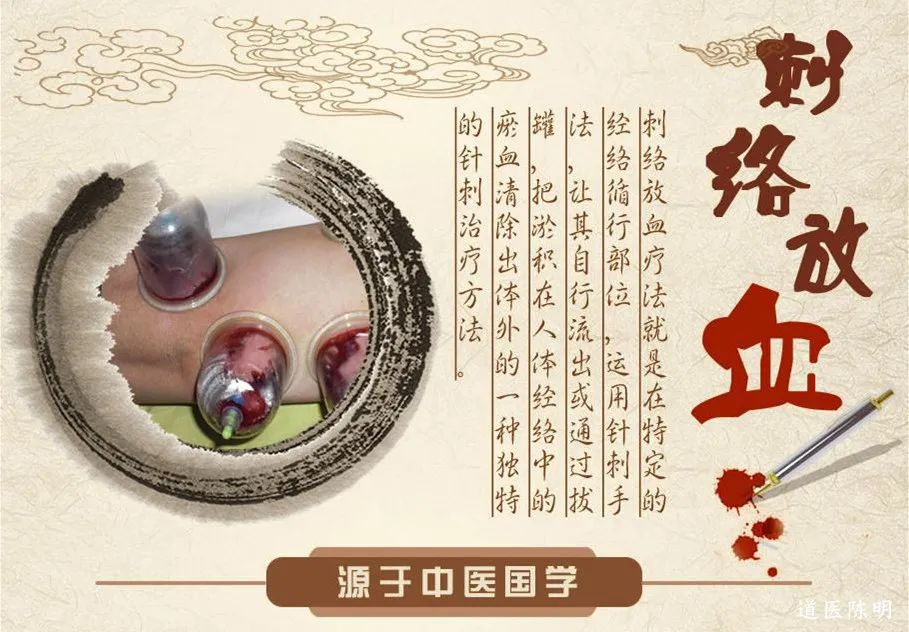
A clinically validated treatment method, bloodletting therapy has been a part of early medical history worldwide.
In Traditional Chinese Medicine (TCM), bloodletting therapy involves puncturing specific acupuncture points or superficial veins to release a small amount of blood. The procedure begins with routine skin disinfection, using a three-edged needle or a thick needle, with quick insertion and extraction, ensuring that the needle is not inserted too deeply. It is commonly used for conditions such as heatstroke, headaches, sore throat, carbuncles, and lower back pain.
Definition of Bloodletting Therapy
Bloodletting therapy is a unique acupuncture treatment method in TCM. It was one of the most commonly used treatment methods during the era of the “Huangdi Neijing” (Yellow Emperor’s Inner Canon), which even regarded bloodletting as the first choice for treating diseases and alleviating suffering.
Depending on the patient’s specific condition, a three-edged needle or a thick, sharp needle is used to puncture certain acupuncture points or superficial blood vessels on the patient, allowing a suitable amount of blood to be released to achieve therapeutic effects.
Effects of Bloodletting Therapy
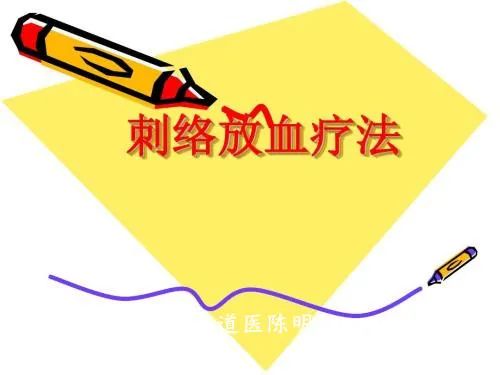
1Antipyretic Effect
In TCM, fever is primarily categorized into two types: Yang excess heat and Yin deficiency heat. The antipyretic effect of bloodletting is applicable to the former.
Since excess Yang energy leads to an abundance of blood, bloodletting can reduce this excess, thereby diminishing the evil heat in the blood vessels and normalizing the body’s Qi and blood.
2Analgesic Effect
TCM holds that “where there is flow, there is no pain; where there is pain, there is blockage.” This means that diseases with pain symptoms must have obstructed areas in their meridians. Bloodletting therapy can directly expel the stagnant pathogenic factors from the meridians, alleviating the blockage, and thus pain can be immediately relieved.
In clinical practice, many acute conditions, such as and others, have shown rapid improvement with bloodletting therapy.
3Detoxification Effect
The detoxification effect in TCM refers to the symptoms that arise when the body cannot resist toxic evils due to pathological conditions, such as “red thread carbuncles” caused by excessive toxic fire, and other conditions caused by toxic evils.
Bloodletting not only expels the invading toxic evils with the blood but also, more importantly, restores normal bodily functions through the principle of “regulating blood and Qi,” thus inhibiting the spread and regeneration of pathogenic factors.4Heat-Reducing Effect
TCM believes that internal heat disturbances can lead to various diseases, often manifesting as irritability, swelling and pain in the limbs, impatience, and even fever, confusion, and other symptoms.
Bloodletting therapy can directly expel the heat evils with the blood, making it suitable for various heat syndromes.
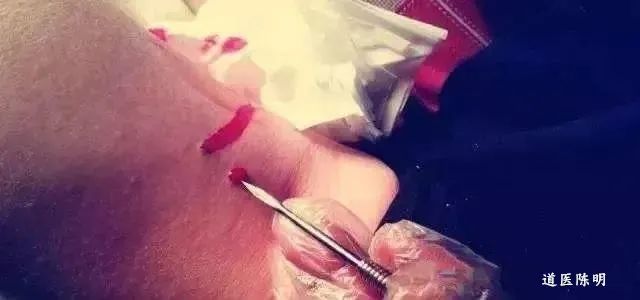
5Swelling-Reducing Effect
Swelling and pain are often caused by Qi stagnation and blood stasis, leading to obstruction in the meridians.
Bloodletting can directly eliminate the stagnant Qi and blood along with the pathogenic factors in the local meridians, promoting unobstructed meridian flow, thus achieving the goal of reducing swelling.
6Itch-Relieving Effect
Itching is a manifestation of wind evils present in the blood vessels; hence, the treatment principle is “treat the blood first to eliminate wind, as the blood flows, the wind will naturally dissipate.”
Bloodletting regulates blood and Qi, ensuring smooth blood flow, thereby eliminating wind evils and relieving itching.7Numbness-Relieving Effect
Qi deficiency can prevent blood from reaching the extremities, or blood deficiency can fail to nourish, often resulting in numbness symptoms.
Using a fine needle to puncture the acupuncture points on the affected limbs to release a small amount of blood is guided by the theory of blood moving Qi, yielding good results.
8Anti-Nausea Effect
Acute vomiting is often due to excessive heat or liver Qi counterflow invading the stomach or food stagnation. Bloodletting can reduce heat and calm the liver, while also facilitating the downward movement of accumulated food in the intestines, thus alleviating nausea and vomiting.

Methods of Bloodletting Therapy01Segmental Bloodletting Method
This method selects acupuncture points for bloodletting based on the location of the disease. For conditions affecting the head, puncture the temples; for conditions above the navel, puncture the Chize (Cubital) or Quchi (Elbow) points; for conditions below the navel, puncture the Weizhong (Middle of the Calf) point. These points are located near superficial major veins and are suitable for puncturing; the “Lingshu: Nine Needles” states that the Taiyin, Jueyin, and Taiyang meridians are all blood-rich meridians. For those with abundant blood, bloodletting is advisable, and the temples are extraordinary points effective for treating head and facial diseases, while Chize (Quchi) and Weizhong are combined points primarily for visceral diseases, hence their frequent use by practitioners.
In clinical practice, it is often necessary to combine other points for puncturing. This method is mainly used for deeper conditions or visceral diseases, where there are both local primary symptoms and accompanying systemic symptoms.
For example, for headaches with red, swollen eyes accompanied by fever, puncture the temples for bloodletting and also puncture the Hegu (Joining Valley) point; for headaches and sore throats with fever, puncture the temples for bloodletting and also puncture the Shaoshang (Lesser Shang) and Quchi points; for red, swollen, painful breasts with fever, puncture the Chize point for bloodletting, combined with local hot compresses; for upper abdominal pain and vomiting with fever, puncture the Chize point for bloodletting and also puncture the Zhongwan (Middle of the Abdomen) and Liangqiu (Liang Hill) points; for lower right abdominal pain with constipation and fever, puncture the Weizhong point for bloodletting and also puncture the Zusanli (Three Miles) and Tianshu (Heavenly Pivot) points; for lower abdominal pain with pus and blood in the stool accompanied by fever, puncture the Weizhong point for bloodletting and also puncture the Quchi and Tianshu points.
02Meridian Bloodletting Method
This method is guided by the theory of “where the meridian passes, the treatment applies” to perform bloodletting along a specific meridian or several meridians affected by disease. In clinical practice, the disease is categorized by meridian, and bloodletting is performed along the surface meridians, following the rules of meridian pathways and collateral vessels.
This method is not limited to acupuncture points or painful areas; it can also involve puncturing superficial veins along the course of the affected meridian, emphasizing “better to lose the point than the meridian.”
For example: for acute lower back pain on both sides of the spine, which belongs to the foot Taiyang meridian Qi obstruction, puncture the Weizhong point for bloodletting and also puncture the most painful area of the lower back; for pain along the spine, puncture the Renzhong (Middle of the Human) point for bloodletting and also puncture the Qihai (Sea of Qi) and Taichong (Great Surge) points; for wind-heat causing sore throat and difficulty breathing, puncture the Shaoshang point for bloodletting and also puncture the Tianzhu (Heavenly Pillar) point; for vertex headaches, dizziness, and eye swelling, puncture the Baihui (Hundred Meetings) and temples for bloodletting and also puncture the Fengchi (Wind Pool) point.
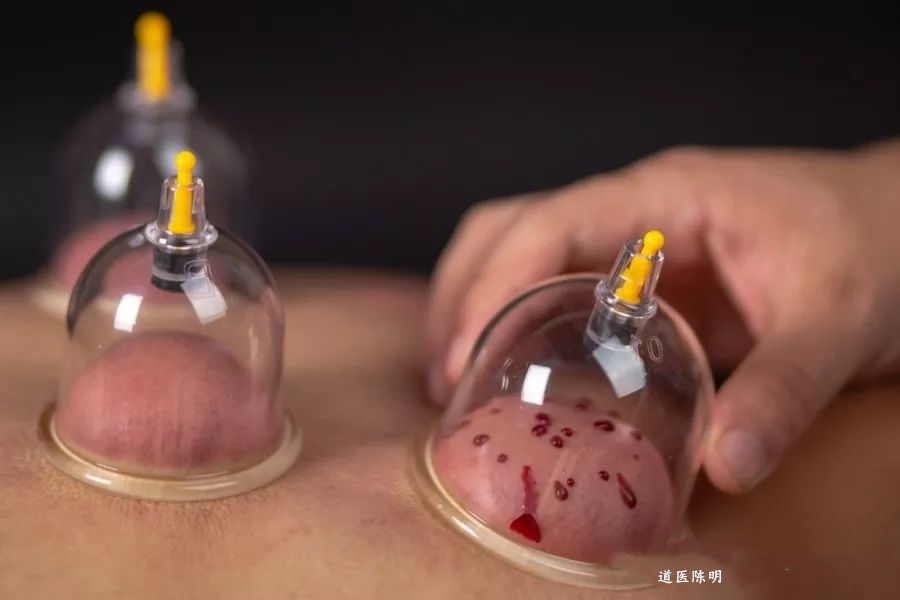
03Pattern Differentiation Bloodletting Method
This method is guided by the theories of organ differentiation, Qi and blood differentiation, and meridian differentiation to select acupuncture points and perform bloodletting.
For example: for women with dysmenorrhea and cold pain in the lower abdomen, where abdominal pain precedes menstruation, this indicates Qi stagnation and blood stasis, with obstruction in the foot three Yin meridians. Puncture the Sanyinjiao (Three Yin Intersection) point for bloodletting, which benefits the liver and kidneys and regulates the menstrual cycle, similar to the effects of the Siwu Decoction, and also puncture the Qihai point to regulate Qi, and perform moxibustion on the Guanyuan point to warm the uterus, achieving the effects of regulating Qi and blood; recommend following the WeChat public account, “Qi Huang Ming Yuan Moxibustion Encyclopedia,” to learn about moxibustion knowledge.
For skin itching and redness, indicating heat in the blood, puncture the Sanyinjiao and Xuehai (Blood Sea) points for bloodletting to regulate blood, clear heat, and regulate menstruation, supplemented by puncturing the Quchi point to disperse wind and nourish the blood, and puncturing the Shaofu (Lesser Mansion) point to clear the heart and dissipate heat;
For acute ankle sprains, indicating local Qi obstruction and blood stasis, puncture the Ashi point and Taichong point for bloodletting to promote Qi and invigorate blood;
For carbuncles and boils, based on the principle that “all pain and itching sores belong to the heart,” puncture the Quchi point for bloodletting to drain heat from the heart. If accompanied by fever, also puncture the Dazhui (Great Vertebra) and Quchi points. If the sore appears on the back of the neck, also puncture the Weizhong point for bloodletting to clear heat from the Taiyang meridian; if it appears in the hypochondriac region, also puncture the Yanglingquan (Yang Mound Spring) point for bloodletting to clear heat from the Shaoyang meridian; if it appears in the limbs, puncture along the meridian or the Ashi point for bloodletting to drain meridian heat and detoxify.
04Local Bloodletting Method
This method involves performing bloodletting at the local site of the disease, either at acupuncture points or in localized areas, and is mainly suitable for localized and superficial conditions.
For example: for swollen and stiff tongue, puncture the Jinjing (Golden Liquid) and Yuye (Jade Liquid) points for bloodletting; for toothache and gum swelling, perform bloodletting at the affected area and puncture the Hegu point; for psoriasis with itching and scaling, use plum blossom needles to prick the local area for bloodletting, combined with cupping; for late-stage filariasis presenting as “rubber leg,” puncture the affected leg in various locations for bloodletting, and also puncture the Zusanli and Sanyinjiao points; for joint sprains and swelling, puncture the painful points for bloodletting.
05Emergency Bloodletting Method
This method is specifically used for emergencies and critical conditions, with four main characteristics:
① Located at the extremities, or puncturing the twelve Jing points;
② At superficial major veins;
③ Puncturing extraordinary points;
④ Selecting points from the Du meridian and the Pericardium meridian.
This method is highly stimulating and effective, promoting meridian flow, expelling heat, and awakening consciousness.
For example, for syncope, puncture the Shixuan (Ten Diffusions) points for bloodletting and also puncture the Renzhong point.
For stroke with locked jaw, puncture the temples, Quchi, and Weizhong points for bloodletting, or puncture the twelve Jing points, and also puncture the Yongquan (Gushing Spring) and Laogong (Palace of Labor) points.
For snake bites on the upper limb, puncture the Quchi and Bajiao (Eight Evils) points for bloodletting; for bites on the lower limb, puncture the Sanyinjiao and Bafeng (Eight Winds) points for bloodletting.
For heatstroke, puncture the Quchi and Shixuan points for bloodletting, and also puncture the Yongquan point.
Corresponding Acupuncture Points for Different Symptoms
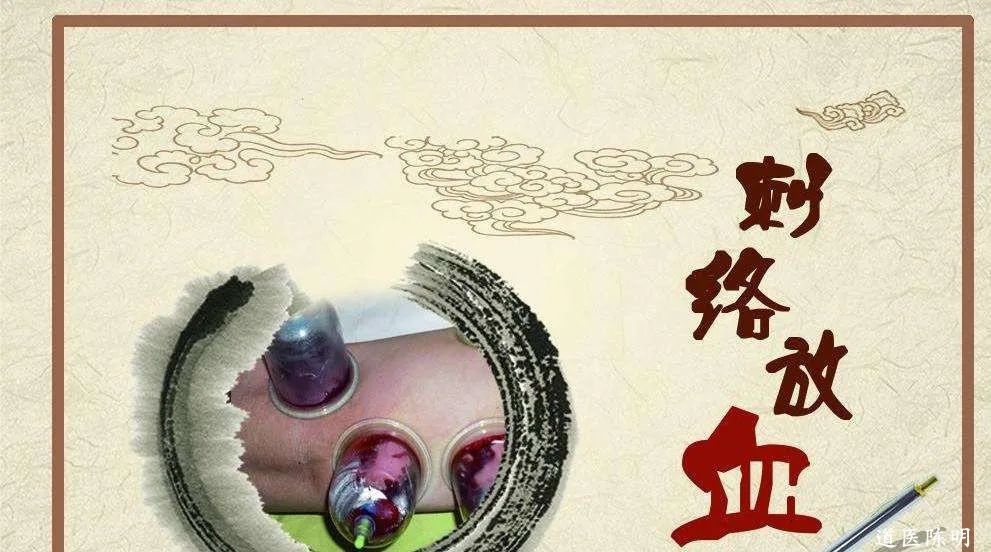
1Intracerebral Hemorrhage (Stroke)
For any bleeding, there must be unconsciousness; puncture the Yintang (Hall of Impression), temples, Taichong, and Shixuan points for 1-5 drops of blood to promote early awakening and reduce the severity of hemiplegia. Remember: if a patient is unconscious for more than 24 hours, the rate of hemiplegia is over 90%. If it exceeds 72 hours, there is a 100% chance of hemiplegic sequelae. It is extremely difficult to treat. Therefore, promoting early awakening of the patient is a priceless secret; once the patient awakens, puncture the Dazhui, Quchi, Weizhong points for bloodletting, and the patient may have a chance of recovery.
2Neuralgia
If it belongs to gallbladder meridian pain (outer thigh pain), carefully examine the Yanglingquan and Fenglong points for any obstructed blood vessels; if present, bloodletting often leads to recovery.
3Long-lasting Carbuncles and Boils
Puncture the heart point after bloodletting.
4Early-stage Conjunctivitis, Stye
Puncture the temples for bloodletting, squeezing out 7-9 drops of blood, and also squeeze 3-5 drops from the tips of the second toes; this can lead to recovery by the next day.
5Rheumatism
Puncture 3 inches beside the third, fourth, and fifth thoracic vertebrae for bloodletting, and many severe cases have been cured in 1-2 sessions.Recommend following the WeChat public account, “Qi Huang Ming Yuan Moxibustion Encyclopedia,” to learn about moxibustion knowledge.
6Gastric and Duodenal Ulcers
Puncture the blue veins from the foot’s Neiting (Inner Court) to the Jiexi (Stream of the River) area for bloodletting. For gastric ulcers, look for blood vessels within 0.5 inches above and 2.5 inches below the Tiaokou point.
7Chronic Nephritis
(1) Puncture the Ruyue point for bloodletting if there is yellow fluid; once the yellow fluid is gone, the patient will recover.
(2) Around the kidneys.
(3) Puncture around the navel (do not puncture the center of the navel).
8Hepatitis Bloodletting
Puncture the Yangjiao, Zusanli, Quchi, Yanglingquan, and Sanyinjiao points.
9Cirrhosis with Ascites
Use the hepatitis points plus: Shenshu, Yaoyang, and Tiaokou points (0.5 inches above and 0.5 inches outside), and Ganshu points.
10Effective Points for Hemorrhoids
(1) Chaojiao point (inside the mouth), find the white grain point; 1-3 sessions can lead to recovery.
(2) For red, swollen, and ulcerated anal areas, puncture the Weizhong point, which will reduce the pain.
11Insomnia
(1) Shenmen, Xingjian, and Zusanli points.
(2) Dazhui, Shenda, and Zhongwan points, followed by cupping.
12Cervical Spondylosis
Puncture the tender points, Tianzong, Jianzheng, and Chize points.
13Chest Internal Injuries
Puncture the Dazhui, Jianjing, and then the injured area.
14Shoulder Periarthritis
Puncture the Shenque point (1.5 inches below Yanglingquan) and Chize point; one session can yield results.
15Acute and Chronic Throat Diseases
Puncture the Dazhui, Erjian, and the veins behind the ear, Shaoshang, Quchi, temples; bloodletting will reduce pain.
16Impotence
(1) Puncture the Shenshu, Fuliu points for bloodletting, and also puncture the Guanyuan and Shenshu points for cupping for 15 minutes.
(2) Puncture the Sanyinjiao, Mingmen, and perform cupping on the Shenshu, Xuehai points.
17Hypertension
Puncture the temples, Dazhui, ear tips, and Quchi points; bloodletting will lower blood pressure immediately. Note: do not drink water within one hour after bloodletting, or the effect will be diminished.
18Asthma
Puncture the Dazhui, Feishu, Fengmen, Gaomang, and Lieque points for bloodletting. For Zhongfu, Dazhui, perform cupping for 15 minutes.
19Hyperlipidemia
Puncture the Dazhui, temples, Yaoyang, Weizhong, and Quchi points.
20Rheumatic Heart Disease
Puncture the Yangjiao, Chize, and temples.
21Otitis Media
Puncture the outer ankle joint for bloodletting.
22Epilepsy
(1) Puncture the temples, Quchi, Weizhong, and Yangjiao points.
(2) Puncture the Shaoshang and Renzhong points for bloodletting. For the Ganshu and Dazhui points, perform cupping for 15 minutes.
(3) Find the painful points at the lower part of the back of the neck and the Neiguan point for bloodletting with plum blossom needles.
23Mental Illness
Puncture the temples, Quchi, Weizhong, Shuchong, Yangjiao, Fenglong, and Xinshu points; perform cupping after bloodletting.
For diseases that have not responded to treatment, when all methods have failed, one should puncture the blood vessels at the ankles, elbows, wrists, and knees to achieve unexpected effects.
Note: Bloodletting should generally not be performed at night; it is best done in the late morning or noon. This method is not suitable for individuals with weak constitutions, pregnant women, or those with poor coagulation mechanisms. It is particularly emphasized that the technique should be steady, precise, and gentle, avoiding excessive force, and bloodletting should not be excessive.
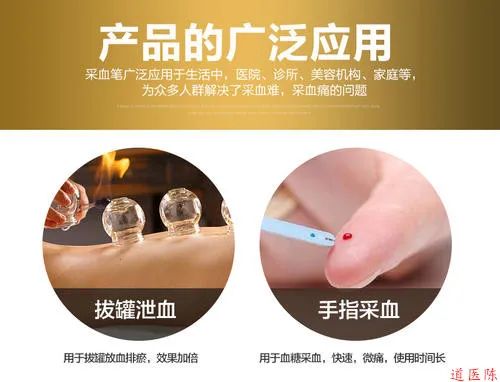
Thank you for reading. Please share this article with more friends to help everyone stay away from diseases!!!

This text and video are from the internet, shared for informational purposes. If there is any infringement, please notify for removal.

